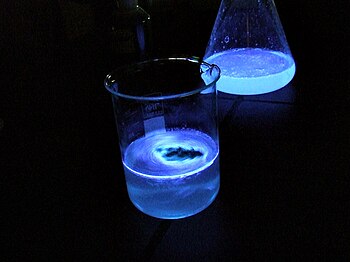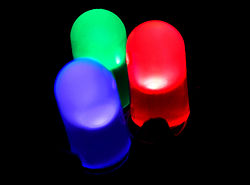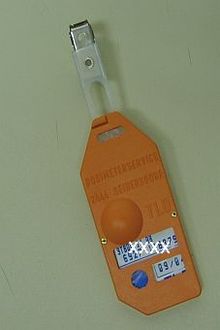 |
| Luminol and haemoglobin, an example of chemiluminescence (Photo credit: Wikipedia) |
 the emission of light as a result of a chemical reaction
the emission of light as a result of a chemical reaction
(sometimes "chemoluminescence") is the emission of light (luminescence), as the result of a chemical reaction. There may also be limited emission of heat
1.1 Bioluminescence,
a result of biochemical reactions in a living organism

1.2 Electrochemiluminescence,
a result of an electrochemical reaction
Quite interesting medical application of electroluminiscence from Roche:
1.3 Lyoluminescence,
a result of dissolving a solid (usually heavily irradiated) in a liquid solvent
2. Crystalloluminescence,
produced during crystallization
3. Electroluminescence,
a result of an electric current passed through a substance

Electroluminescence (EL) is an optical phenomenon and electrical phenomenonin which a material emits light in response to the passage of an electric current or to a strong electric field. This is distinct from black body light emission resulting from heat (incandescence), from a chemical reaction (chemiluminescence), sound (sonoluminescence), or other mechanical action (mechanoluminescence).
3.1 Cathodoluminescence,
a result of a luminescent material being struck by electrons

Cathodoluminescence is an opticaland electromagnetic phenomenon in which electrons impacting on aluminescent material such as aphosphor, cause the emission ofphotons which may have wavelengths in the visible spectrum. A familiar example is the generation of light by an electron beam scanning the phosphor-coated inner surface of the screen of a television that uses a cathode ray tube.
4 Mechanoluminescence,
a result of a mechanical action on a solid
4.1 Triboluminescence,
generated when bonds in a material are broken when that material is scratched, crushed, or rubbed

Triboluminescence is an optical phenomenon in which light is generated through the breaking of chemical bonds in a material when it is pulled apart, ripped, scratched, crushed, or rubbed (see tribology). The phenomenon is not fully understood, but appears to be caused by the separation and reunification of electrical charges. The term comes from the Greek τρίβειν("to rub"; see tribology) and the Latin lumen (light). Triboluminescence can be observed when breaking sugar crystals and peeling adhesive tapes.
4.2 Fractoluminescence,
generated when bonds in certain crystals are broken by fractures
4.3 Piezoluminescence,
produced by the action of pressure on certain solids
4.4 Sonoluminescence,
a result of imploding bubbles in a liquid when excited by sound

Sonoluminescence is the emission of short bursts of light from implodingbubbles in a liquid when excited by sound.
5 Photoluminescence,
a result of absorption of photons

Photoluminescence (abbreviated asPL) is light emission from any form of matter after the absorption of photons(electromagnetic radiation). It is one of many forms of luminescence (light emission) and is initiated by photoexcitation (excitation by photons), hence the prefix photo-. Following excitation various relaxation processes typically occur in which other photons are re-radiated.
5.1 Fluorescence,
photoluminescence as a result of singlet–singlet electronic relaxation (typical lifetime: nanoseconds)
 |
| Collection of various fluorescent minerals under ultraviolet UV-A, UV-B and UV-C light. Chemicals in the rocks absorb the ultraviolet light and emit visible light of various colors, a process called fluorescence. Français : Divers minéraux fluorescents Deutsch: Verschiedene fluoreszierende Minerale unter UV-Licht (Photo credit: Wikipedia) |
5.2 Phosphorescence,
photoluminescence as a result of triplet–singlet electronic relaxation (typical lifetime: milliseconds to hours)

Phosphorescence is a specific type ofphotoluminescence related tofluorescence. Unlike fluorescence, a phosphorescent material does not immediately re-emit the radiation it absorbs. The slower time scales of the re-emission are associated with "forbidden" energy state transitions inquantum mechanics. As these transitions occur very slowly in certain materials, absorbed radiation may be re-emitted at a lower intensity for up to several hours after the original excitation.
6 Radioluminescence,
a result of bombardment by ionizing radiation

Radioluminescence is the phenomenon by which light is produced in a material by bombardment withionizing radiation such as beta particles. Radioluminescence is used as a low level light source for night illumination of instruments or signage or other applications where light must be produced for long periods without external energy sources. Radioluminescent paint used to be used for clock hands and instrument dials, enabling them to be read in the dark.
7 Thermoluminescence,
the re-emission of absorbed energy when a substance is heated

Thermoluminescence is a form ofluminescence that is exhibited by certain crystalline materials, such as some minerals, when previously absorbed energy fromelectromagnetic radiation or other ionizing radiation is re-emitted as light upon heating of the material. The phenomenon is distinct from that of black body radiation.
8 Cryoluminescence,
the emission of light when an object is cooled (an example of this is wulfenite)
Applications
Light-emitting diodes (LEDs) emit light via electro-luminescence

Phosphor thermometry, measuring temperature using phosphorescence



Further reading:
No comments:
Post a Comment